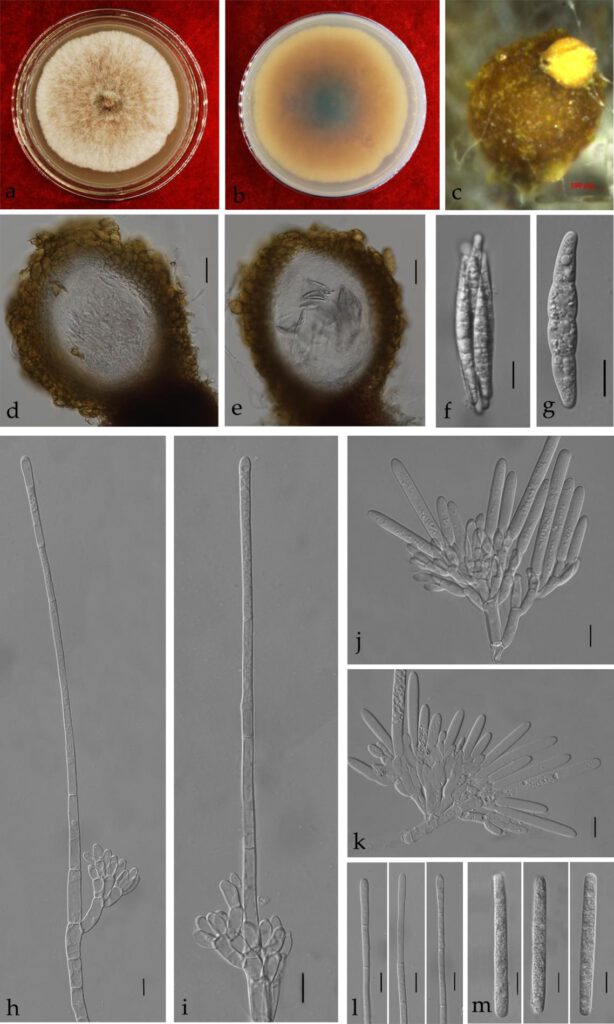Calonectria shaoguanensis Y. X. Zhang, C. T. Chen & Manawas., sp. nov. Fig. 6
Index Fungorum number: IF 555217; Facesoffungi number: FoF 11343;
Etymology – Epithet refers to the Shaoguan city from where the type was collected.
Holotype – ZHKU 21-0033
Micromorphology: Associated with leaf spot of Callistemon rigidus. Telemorph: Perithecia 250–500 × 200–380 µm, solitary, yellow orange, subglobose to ovoid, and perithecial walls rough. Asci fusiform with 8-spored. Ascospores (45–)50–70 × (3–)4–8(–9) µm (x̄ = 56.5 × 6.5 µm, n=50), hyaline, fusiform, straight to curved, 1-septate, sometimes constricted at septum. Anamorph: Macroconidiophores septate, hyaline. Primary branches of conidiogenous apparatus 10–25 × 3–8 μm; secondary branches aseptate, 10–18 × 3–7 μm; tertiary branches aseptate, 8–15 × 3–6 μm; each terminal branch producing 2–4 phialides, 7–12 × 2–5 μm. Veslcles (2–)4–7 μm diam, narrowly clavate. Macroconidia (55–)60–70(–75) × (4–)5–8 μm (x̄ = 65 × 6.5 μm, n=50), cylindrical, straight, 1–3 septate. Megaconidia and microconidia not observed.
Culture characteristics: Colonies fast growing at 25 ℃ on MEA, growth rate 10 mm/d (n = 5), circular, producing abundant white aerial mycelium, reverse red brown.
Material examined: China, Guangdong province, Shaoguan city, Callistemon rigidus R. Br., (Myrtaceae). 21st June 2020, Y.X. Zhang (dried cultures ZHKU 21-0033 holotype; ZHKU 21-0034), and living culture, ZHKUCC 21-0036 ex–holotype; ZHKUCC 21-0037.
Notes: Our isolates from C. rigidus formed a distinct clade from the other six closely related species with less than 50 % ML and MP bootstrap support and 1.00 BYPP support. Morphologically our isolate differs from Ca. eucalypti, Ca. paracolhounii, Ca.monticola, and Ca. honghensis by the size of macroconidia. Our isolate (65 × 6.5 μm) developed macroconidia larger than Ca. paracolhounii (41 × 5 μm), Ca.monticola (49 × 5 μm) and Ca. honghensis (54 × 5.5 μm), shorter and broader than Ca. eucalypti (72 × 6 μm) and Ca. aciculata (69 × 5.5 μm). In addition, our isolates are different from Ca. colhounii in the number of ascosporous septa [1 vs (1–) 3] and macroconidial septa (1–3 vs 1), as well as the size of vesicle (4–7 μm vs 3–4 μm diam.). In the PHI analysis of closely related taxa, there is no significant evidence of recombination among our isolate and other related species. Based on these polyphasic approaches we introduce Calonectria shaoguanensis as novel species from Callistemon rigidus.

Figure 6. Calonectria shanguanensis (ZHKUCC 21-0036: Ex-holotype) a–b: Culture characteristics on MEA after 7 days (a, upper view; b, reverse view); c: Ascomata; d–e: Vertical section through ascomata; f: A ascus; g: A ascospore; h–i: Macroconidiophores; j–k: Conidiogenous apparatus; l: Vesicles; m : Macroconidia; Scale bars: c = 100 μm; d–e = 50 μm; f–m = 10 μm.
